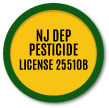 Weed Management in Stewartsville, NJ
Weed Management in Stewartsville, NJ
Weeds in your Lawn, and Why
“What do I do about the weeds in my lawn? Is there something I can spray?” These are common questions asked by homeowners each year. A better question would be, “Why do I have weeds in my lawn?” Weeds invade your lawn because at some point there is room or space (along with other growth requirements) available for them to grow. Healthy lawn grasses compete against weeds by forming a closed canopy that limits light and space for weeds to germinate and establish. Thus, the number of weeds present can be an indicator of the competitive health of your lawn. Need more help with weeds, mowing, or insects? Contact us at Sunshine Tree & Landscape today!
Call Now
Weeds
Bittercress
 Bittercress has unique foliage that makes it is easy to identify among other container weeds. The leaflets on the foliage have a club shape, evident here on even small seedlings. Leaves of bittercress seedlings are often simple, while leaves that develop later are generally compound.
Bittercress has unique foliage that makes it is easy to identify among other container weeds. The leaflets on the foliage have a club shape, evident here on even small seedlings. Leaves of bittercress seedlings are often simple, while leaves that develop later are generally compound.
Virginia Buttonweed
 Virginia buttonweed is a prostrate-growing perennial with branching hairy stems. The leaves are elongated, lance-shaped and grow opposite one another on the stems and are joined by a membrane. Virginia buttonweed prefers moist, wet conditions. The tubular flowers of Virginia buttonweed are white to purplish, and grow in the leaf axis along the stem. Flowers resemble four-pointed stars. Virginia buttonweed spreads by seed and plant segments.
Virginia buttonweed is a prostrate-growing perennial with branching hairy stems. The leaves are elongated, lance-shaped and grow opposite one another on the stems and are joined by a membrane. Virginia buttonweed prefers moist, wet conditions. The tubular flowers of Virginia buttonweed are white to purplish, and grow in the leaf axis along the stem. Flowers resemble four-pointed stars. Virginia buttonweed spreads by seed and plant segments.
Chickweed
 Common chickweed, a winter annual, is a low-growing, succulent weed that often spreads out in extensive mats. It may survive summer in shady, cool areas that offer sufficient moisture and occurs year-round along the California coast. Seed leaves have prominent mid veins and are about four times as long as broad, tapering to a point at the tip. True leaves are broader, opposite, and yellow green. Chickweed mats may cover a large area. Stems are trailing, weak, and slender, with a line of hairs down the side. Mature leaves are ovate and opposite on the stem. Flowers are small but showy with five deeply cut white petals.
Common chickweed, a winter annual, is a low-growing, succulent weed that often spreads out in extensive mats. It may survive summer in shady, cool areas that offer sufficient moisture and occurs year-round along the California coast. Seed leaves have prominent mid veins and are about four times as long as broad, tapering to a point at the tip. True leaves are broader, opposite, and yellow green. Chickweed mats may cover a large area. Stems are trailing, weak, and slender, with a line of hairs down the side. Mature leaves are ovate and opposite on the stem. Flowers are small but showy with five deeply cut white petals.
White Clover
 White clover is a perennial with trifoliate leaves, stems that root at the nodes, and white flowers. Leaves are composed of 3 leaflets (trifoliate). Each leaflet is egg-shaped, widest at the apex, 1/2 to 1 1/4 inches long, and has an indentation at the apex. Leaflets usually have a lighter green or white ‘V-shaped’ marking close to their base and a slightly toothed margin. Each trifoliate leaf occurs on a 1-3 inch petiole. Flowers occur on flower stalks (peduncles) that arise from the leaf axils. Each rounded flower head is round or globular in outline, approximately 1/2 to 1 1/4 inches long, and consists of 20-40 individual white flowers.
White clover is a perennial with trifoliate leaves, stems that root at the nodes, and white flowers. Leaves are composed of 3 leaflets (trifoliate). Each leaflet is egg-shaped, widest at the apex, 1/2 to 1 1/4 inches long, and has an indentation at the apex. Leaflets usually have a lighter green or white ‘V-shaped’ marking close to their base and a slightly toothed margin. Each trifoliate leaf occurs on a 1-3 inch petiole. Flowers occur on flower stalks (peduncles) that arise from the leaf axils. Each rounded flower head is round or globular in outline, approximately 1/2 to 1 1/4 inches long, and consists of 20-40 individual white flowers.
Dandelion
 The Dandelion has a thick tap root, dark brown, almost black on the outside though white and milky within. The long jagged leaves rise directly, radiating from it to form a rosette lying close upon the ground. The shining, purplish flower-stalks rise straight from the root, are leafless, smooth and hollow and bear single heads of flowers. Dandelion seeds are carried away by the wind and travel like tiny parachutes. A strong wind can carry the seeds miles away from the parent plant.
The Dandelion has a thick tap root, dark brown, almost black on the outside though white and milky within. The long jagged leaves rise directly, radiating from it to form a rosette lying close upon the ground. The shining, purplish flower-stalks rise straight from the root, are leafless, smooth and hollow and bear single heads of flowers. Dandelion seeds are carried away by the wind and travel like tiny parachutes. A strong wind can carry the seeds miles away from the parent plant.
Dogfennell
 Dogfennell, a perennial with finely dissected leaves that may reach 6 1/2 feet in height. Seeds are oval, and are without hairs. The first true leaves are opposite and subsequent leaves become finely divided like those of the mature plant.
Dogfennell, a perennial with finely dissected leaves that may reach 6 1/2 feet in height. Seeds are oval, and are without hairs. The first true leaves are opposite and subsequent leaves become finely divided like those of the mature plant.
Henbit
 Henbit is a winter annual with square stems and pink-purple flowers, reaching 16 inches in height. Its leaves are opposite, reaching 5 inches in length, circular to heart-shaped, with hairs on the upper leaf surfaces and along the veins of the lower surface. Leaf margins have rounded teeth. Stems root at the lower nodes, are square in cross section and are covered with downward-pointing hairs. Flowers are pink to purple in color and are fused into a tube approximately 2/3 inch long.
Henbit is a winter annual with square stems and pink-purple flowers, reaching 16 inches in height. Its leaves are opposite, reaching 5 inches in length, circular to heart-shaped, with hairs on the upper leaf surfaces and along the veins of the lower surface. Leaf margins have rounded teeth. Stems root at the lower nodes, are square in cross section and are covered with downward-pointing hairs. Flowers are pink to purple in color and are fused into a tube approximately 2/3 inch long.
Lespedeza
 Lespedeza is a prostrate, freely-branched summer annual with inconspicuous purplish flowers forming mats 15 to 18 inches in diameter. Found throughout the southeast. Lespedeza has a strong, firm taproot. Its leaves consist of 3 oblong leaflets (trifoliolate), 1/2 to 3/4 inch long and 1/3 to 1/2 as wide, obtuse at apex, narrowed at the base. The stems are also firm and woody.
Lespedeza is a prostrate, freely-branched summer annual with inconspicuous purplish flowers forming mats 15 to 18 inches in diameter. Found throughout the southeast. Lespedeza has a strong, firm taproot. Its leaves consist of 3 oblong leaflets (trifoliolate), 1/2 to 3/4 inch long and 1/3 to 1/2 as wide, obtuse at apex, narrowed at the base. The stems are also firm and woody.
Oxalis
 Oxalis, a perennial with trifoliate leaves and yellow flowers. Its leaves are arranged alternately along the stem, long-petiolated, and divided into 3 heart-shaped leaflets. Leaf margins are smooth but fringed with hairs. The stems are green to pink, weak, branched at base. The flowers occur in clusters that arise from long stalks at the leaf axils. Individual flowers consist of 5 yellow petals. The roots are long, slender rhizomes occur with a fibrous root system.
Oxalis, a perennial with trifoliate leaves and yellow flowers. Its leaves are arranged alternately along the stem, long-petiolated, and divided into 3 heart-shaped leaflets. Leaf margins are smooth but fringed with hairs. The stems are green to pink, weak, branched at base. The flowers occur in clusters that arise from long stalks at the leaf axils. Individual flowers consist of 5 yellow petals. The roots are long, slender rhizomes occur with a fibrous root system.
Pigweed
 Pigweed, an erect summer annual that is prevalent in lawns during spring periods. It is most abundant during rainy periods. The leaves are alternate, light green, ovate in outline, with petioles that reach 1/2 inch in length. Leaves have wavy margins and hairs that occur along the veins of the lower leaf surfaces. Pigweed’s roots are very shallow. The roots often grow in thatch rather than in the soil. The shallow taproot is often, but not always, reddish in color.
Pigweed, an erect summer annual that is prevalent in lawns during spring periods. It is most abundant during rainy periods. The leaves are alternate, light green, ovate in outline, with petioles that reach 1/2 inch in length. Leaves have wavy margins and hairs that occur along the veins of the lower leaf surfaces. Pigweed’s roots are very shallow. The roots often grow in thatch rather than in the soil. The shallow taproot is often, but not always, reddish in color.
Plantain
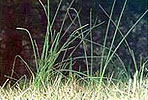 Plantain is a perennial. It grows in a basal rosette with broad oval leaves. Its roots are fibrous with a strong taproot. Its leaves are smooth or slightly hairy, oval to elliptic, with a waxy surface and veins that are parallel to the margins. Margins are untoothed and sometimes wavy. Flowers produced on unbranched stalks (scapes) that arise from the rosette. Flowering stems are 5-15 inches long, clustered with small flowers that have whitish petals and bracts surrounding the flowers.
Plantain is a perennial. It grows in a basal rosette with broad oval leaves. Its roots are fibrous with a strong taproot. Its leaves are smooth or slightly hairy, oval to elliptic, with a waxy surface and veins that are parallel to the margins. Margins are untoothed and sometimes wavy. Flowers produced on unbranched stalks (scapes) that arise from the rosette. Flowering stems are 5-15 inches long, clustered with small flowers that have whitish petals and bracts surrounding the flowers.
Speedwell
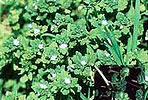 Speedwell is a winter annual that germinates in mid-fall. Speedwells have a short tap root to fibrous root systems and branching upright stems. The lower leaves are near round with toothed margins. The upper leaves are more pointed. The plant is covered with fine hairs. Corn Speedwell flowers are small and white to blue in color. The flowers are found in the leaf axis and the seed develops into a distinctive heart shape.
Speedwell is a winter annual that germinates in mid-fall. Speedwells have a short tap root to fibrous root systems and branching upright stems. The lower leaves are near round with toothed margins. The upper leaves are more pointed. The plant is covered with fine hairs. Corn Speedwell flowers are small and white to blue in color. The flowers are found in the leaf axis and the seed develops into a distinctive heart shape.
Spotted Spurge
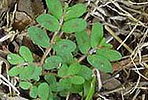 Spotted spurge is a summer annual. While similar to prostate spurge, there are several subtle differences in the two varieties. Spotted spurge has a more erect growth habit than prostrate spurge. Its leaves are small and oblong shaped with an irregular red to purple spot in the center. The leaves that grow opposite on the stem. Spurge contains a milky sap in the stem. The flower of spotted spurge is small and green in color. It germinates in mid spring and flowers from June to September.
Spotted spurge is a summer annual. While similar to prostate spurge, there are several subtle differences in the two varieties. Spotted spurge has a more erect growth habit than prostrate spurge. Its leaves are small and oblong shaped with an irregular red to purple spot in the center. The leaves that grow opposite on the stem. Spurge contains a milky sap in the stem. The flower of spotted spurge is small and green in color. It germinates in mid spring and flowers from June to September.
Wild Geranium
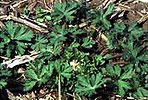 Wild geranium, also called Carolina geranium, is a semi-erect winter annual. The erect stems are branching and covered with hair. The alternate leaves are on long petioles and are divided into segmented leaflets which are blunt toothed. The flowers have 5 white to pink petals and form in clusters. The seed forms in a fruit capsule that forms a “storks bill”.
Wild geranium, also called Carolina geranium, is a semi-erect winter annual. The erect stems are branching and covered with hair. The alternate leaves are on long petioles and are divided into segmented leaflets which are blunt toothed. The flowers have 5 white to pink petals and form in clusters. The seed forms in a fruit capsule that forms a “storks bill”.
Wild Onion
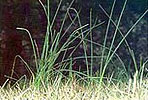 Wild onion and wild garlic are both winter perennials. The leaves are waxy, upright and needle shaped growing 8-12 inches long. The leaves of wild garlic are hollow and round and have a strong odor. The leaves of wild onion are solid and flat and appear directly from the bulb. Both plants grow from underground bulbs. The membrane-coated bulbs of wild garlic are flattened on one side and have bulblets. Wild onion bulbs are white inside with a strong odor and are covered with a fibrous, scaly coat. The white to light green flowers of wild garlic develop on short stems above aerial bulbs.Wild onion does not have a stem; white to pink flowers with six elliptical segments. Both wild onion and wild garlic spread by bulbs, seed and bulblets. Both plants flower from April through June.
Wild onion and wild garlic are both winter perennials. The leaves are waxy, upright and needle shaped growing 8-12 inches long. The leaves of wild garlic are hollow and round and have a strong odor. The leaves of wild onion are solid and flat and appear directly from the bulb. Both plants grow from underground bulbs. The membrane-coated bulbs of wild garlic are flattened on one side and have bulblets. Wild onion bulbs are white inside with a strong odor and are covered with a fibrous, scaly coat. The white to light green flowers of wild garlic develop on short stems above aerial bulbs.Wild onion does not have a stem; white to pink flowers with six elliptical segments. Both wild onion and wild garlic spread by bulbs, seed and bulblets. Both plants flower from April through June.
Wild Violet
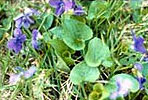 Wild violet is a winter perennial, growing 2 – 5 inches tall. It can have a tap root or a fibrous root system, and also can produce rooting stolons and rhizomes. The leaves can vary but usually are heart shaped, on long petioles with scalloped to shallow rounded margins. The flowers of wild violet range from white to blue to purple and appear from March to June. Wild violet flowers are pansy-like with three lower petals and two lateral petals on long single flower stalks. Crabgrass is a summer annual that germinates when soil temperatures reach a consistent 55 degrees F and is generally killed at the first frost.
Wild violet is a winter perennial, growing 2 – 5 inches tall. It can have a tap root or a fibrous root system, and also can produce rooting stolons and rhizomes. The leaves can vary but usually are heart shaped, on long petioles with scalloped to shallow rounded margins. The flowers of wild violet range from white to blue to purple and appear from March to June. Wild violet flowers are pansy-like with three lower petals and two lateral petals on long single flower stalks. Crabgrass is a summer annual that germinates when soil temperatures reach a consistent 55 degrees F and is generally killed at the first frost.
Crabgrass
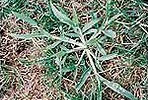 Crabgrass leaves are rolled in the bud; the first leaf appears short, wide and blunt-tipped. The ligule is tall and membranous with jagged edges, and the auricles are absent. The collar is broad with long hairs. Crabgrass is light green in color, coarse bladed and will root at the nodes when they touch the ground. A single crabgrass plant can produce up to 700 tillers. It is a bunch type grass. The inflorescence is a panicle of branches, with spikelets in two rows. A crabgrass plant can produce 150,000 seeds. Crabgrass needs warm soils and sunlight to germinate.
Crabgrass leaves are rolled in the bud; the first leaf appears short, wide and blunt-tipped. The ligule is tall and membranous with jagged edges, and the auricles are absent. The collar is broad with long hairs. Crabgrass is light green in color, coarse bladed and will root at the nodes when they touch the ground. A single crabgrass plant can produce up to 700 tillers. It is a bunch type grass. The inflorescence is a panicle of branches, with spikelets in two rows. A crabgrass plant can produce 150,000 seeds. Crabgrass needs warm soils and sunlight to germinate.
Dallisgrass
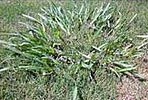 Dallisgrass is a warm season coarse perennial which is light green in color. The leaves are rolled in the bud, flat and wide (1/2″). Auricles are absent and the ligule is tall, pointed, and membranous. Dallisgrass has hairs on the lower portion of the leaf near the ligule. The seedhead contains 3 – 6 spikes, with seeds on both sides of the spike. Dallisgrass can from short thick rhizomes, but spreads upright in clumps. This highly invasive plant germinates in soil temperatures of 60 to 65 degrees F and thrives in the hot humid conditions of the southern states.
Dallisgrass is a warm season coarse perennial which is light green in color. The leaves are rolled in the bud, flat and wide (1/2″). Auricles are absent and the ligule is tall, pointed, and membranous. Dallisgrass has hairs on the lower portion of the leaf near the ligule. The seedhead contains 3 – 6 spikes, with seeds on both sides of the spike. Dallisgrass can from short thick rhizomes, but spreads upright in clumps. This highly invasive plant germinates in soil temperatures of 60 to 65 degrees F and thrives in the hot humid conditions of the southern states.
Tall Fescue
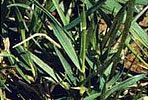 Tall Fescue is a deep rooted, cool season perennial grass. Tall fescue does produce short rhizomes but has a bunch-type growth habit – it spreads primarily by erect tillers. Leaf blades are glossy on the underside and serrated on the margins.
Tall Fescue is a deep rooted, cool season perennial grass. Tall fescue does produce short rhizomes but has a bunch-type growth habit – it spreads primarily by erect tillers. Leaf blades are glossy on the underside and serrated on the margins.
Sedges
 Sedges have triangular stems with waxy grass-like leaves which alternate. Sedges are not grass plants, but seedlings may be mistaken for grass. The leaves on both sedges are waxy and have an up right growth habit and a prominent midrib. Both sedges have underground root systems containing rhizomes and underground tubers which accomplish most of the reproduction. On yellow nutsedge, the tubers (nutlets) form at the end of whitish rhizomes.
Sedges have triangular stems with waxy grass-like leaves which alternate. Sedges are not grass plants, but seedlings may be mistaken for grass. The leaves on both sedges are waxy and have an up right growth habit and a prominent midrib. Both sedges have underground root systems containing rhizomes and underground tubers which accomplish most of the reproduction. On yellow nutsedge, the tubers (nutlets) form at the end of whitish rhizomes.
Purple Nutsedge
 Purple nutsedge forms chains of tubers along brownish rhizomes. The flowers of yellow nutsedge are yellowish; the seedhead color of purple nutsedge is red-purple to brown. Both seedheads are on triangular stems. Both spread mainly by germinating underground tubers, which are the only part of the plant that over-winters. A yellow nutsedge tuber can produce 1,900 plants and 7,000 new tubers in a single growing season. Sedges do well where soil has poor drainage. Orchardgrass is a perennial grass that is blue-green in color. The leaves are folded in the bud, the ligule is very tall membranous, and auricles are absent.
Purple nutsedge forms chains of tubers along brownish rhizomes. The flowers of yellow nutsedge are yellowish; the seedhead color of purple nutsedge is red-purple to brown. Both seedheads are on triangular stems. Both spread mainly by germinating underground tubers, which are the only part of the plant that over-winters. A yellow nutsedge tuber can produce 1,900 plants and 7,000 new tubers in a single growing season. Sedges do well where soil has poor drainage. Orchardgrass is a perennial grass that is blue-green in color. The leaves are folded in the bud, the ligule is very tall membranous, and auricles are absent.
Orchardgrass
 Orchardgrass only contains tillers, resulting in clumps. Orchardgrass can tolerate close mowing. The roots are very fibrous and dense. Orchardgrass remains green throughout the year. The seedhead is a stiff-branched panicle. Seedheads occur from late spring through mid summer.
Orchardgrass only contains tillers, resulting in clumps. Orchardgrass can tolerate close mowing. The roots are very fibrous and dense. Orchardgrass remains green throughout the year. The seedhead is a stiff-branched panicle. Seedheads occur from late spring through mid summer.
Annual Bluegrass
 Annual bluegrass contains both annual and perennial species. Annual bluegrass forms dense patches that can withstand low mowing heights. Annual bluegrass has a boat-shaped tip, folded in the bud. The ligule is membranous and auricles are absent. It germinates in the fall and can be an eyesore in dormant warm season lawns during the winter.
Annual bluegrass contains both annual and perennial species. Annual bluegrass forms dense patches that can withstand low mowing heights. Annual bluegrass has a boat-shaped tip, folded in the bud. The ligule is membranous and auricles are absent. It germinates in the fall and can be an eyesore in dormant warm season lawns during the winter.


